
Hexen: Beyond Heretic is a fantasy first-person shooter video game developed by Raven Software and published by id Software distributed through GT Interactive on October 30, 1995. It is the indirect sequel to 1994's Heretic, and the second game in Raven Software's "Serpent Riders" trilogy, which culminated with Hexen II. The title comes from the German noun Hexen, which means "witches", and/or the verb hexen, which means "to cast a spell". Game producer John Romero stated that a third, unreleased game in this series was to be called Hecatomb.

Nights into Dreams is a 1996 action game developed by Sonic Team and published by Sega for the Sega Saturn. The story follows the teenagers Elliot Edwards and Claris Sinclair, who enter Nightopia, a dream world where all dreams take place. With the help of Nights, an exiled "Nightmaren", they begin a journey to stop the evil ruler Wizeman from destroying Nightopia and consequently the real world. Players control Nights flying through Elliot and Claris's dreams to gather enough energy to defeat Wizeman and save Nightopia. The game is presented in 3D and imposes time limits on every level, in which the player must accumulate points to proceed.

The Sega Saturn is a home video game console developed by Sega and released on November 22, 1994, in Japan, May 11, 1995, in North America, and July 8, 1995, in Europe. Part of the fifth generation of video game consoles, it is the successor to the successful Genesis. The Saturn has a dual-CPU architecture and eight processors. Its games are in CD-ROM format, including several ports of arcade games and original games.

Sonic Adventure is a 1998 platform game developed by Sonic Team and published by Sega for the Dreamcast. It was the first main Sonic the Hedgehog game to feature 3D gameplay. It follows Sonic the Hedgehog, Miles "Tails" Prower, Knuckles the Echidna, Amy Rose, Big the Cat, and E-102 Gamma in their quests to collect the Chaos Emeralds and stop Doctor Robotnik from unleashing Chaos, an ancient evil. Controlling one of the six characters—each with their own abilities—players complete levels to progress the story. Sonic Adventure retains many elements from prior Sonic games, such as power-ups and the ring-based health system. Players can play minigames such as racing and interact with Chao, a virtual pet.
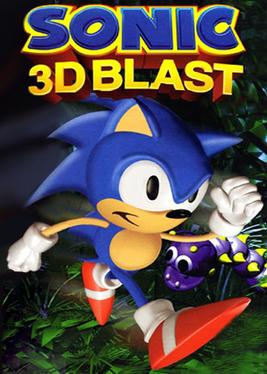
Sonic 3D Blast, known in Europe and Japan as Sonic 3D: Flickies' Island, is a 1996 platform game in the Sonic the Hedgehog series for the Sega Genesis and Sega Saturn. As Sonic the Hedgehog, the player embarks on a journey to save the Flickies, birds enslaved by Doctor Robotnik. The player must guide Sonic through a series of themed levels to collect Flickies and defeat Robotnik. Though it retains game mechanics from prior Sonic games, Sonic 3D Blast is differentiated by its 2D isometric perspective, with pre-rendered 3D models converted into sprites.
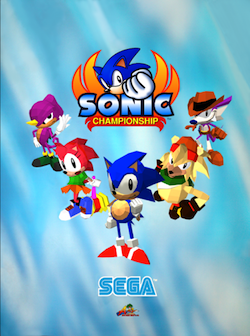
Sonic the Fighters, also known as Sonic Championship on arcade versions outside Japan, is a fighting game developed by Sega AM2. First released in 1996 in arcades on Sega's Model 2 arcade system, Sonic the Fighters pits players in one-on-one battles with a roster of characters from the Sonic the Hedgehog series.

Sonic Jam is a video game compilation developed by Sonic Team and published by Sega for the Sega Saturn. It was released in Japan in June 1997 and in North America and Europe the following August. It contains the four main Sonic the Hedgehog games released on the Sega Genesis: Sonic the Hedgehog (1991), Sonic the Hedgehog 2 (1992), Sonic the Hedgehog 3 (1994) and Sonic & Knuckles (1994). It also features a 3D environment, "Sonic World", which doubles as an interactive museum of Sonic the Hedgehog content.

Earthworm Jim 2 is a 1995 run and gun platform video game and the sequel to Earthworm Jim, and the second and final game in the Earthworm Jim series developed by original creators Doug TenNapel, David Perry and Shiny Entertainment. It was released in late 1995 and early 1996 depending on region and video game console, initially being released for the Sega Genesis and Super Nintendo Entertainment System, before being ported to other platforms.
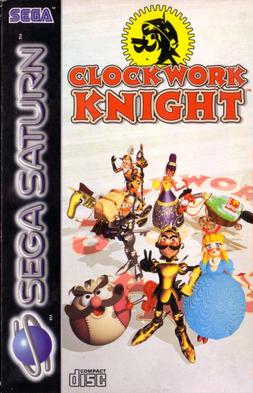
Clockwork Knight is a side-scrolling platform video game developed and published by Sega for the Sega Saturn. It was released in Japan on December 9, 1994, and as a launch title in North America and Europe, on May 11 and July 8, 1995, respectively. It was followed by Clockwork Knight 2.
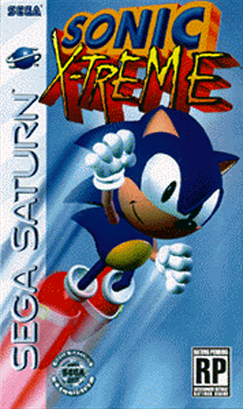
Sonic X-treme was a platform game developed by Sega Technical Institute from 1994 until its cancellation in 1996. It was planned as the first fully 3D Sonic the Hedgehog game, taking Sonic into the 3D era of video games, and the first original Sonic game for the Sega Saturn. The storyline followed Sonic on his journey to stop Dr. Robotnik from stealing six magic rings from Tiara Boobowski and her father. X-treme featured open levels rotating around a fixed center of gravity and, like previous Sonic games, featured collectible rings and fast-paced gameplay.

Sonic R is a 1997 racing game developed by Traveller's Tales and Sonic Team and published by Sega for the Sega Saturn. It is the third racing game in the Sonic the Hedgehog series, and the first to feature 3D computer graphics. The player races one of ten Sonic characters in various Sonic-themed race tracks as they attempt to stop Doctor Robotnik from stealing the Chaos Emeralds and enslaving the world. Sonic R features single-player and multiplayer game modes, and while similar to kart racing games such as Mario Kart, it places an emphasis on jumping and exploration. By collecting items and completing objectives, players can unlock secret characters.
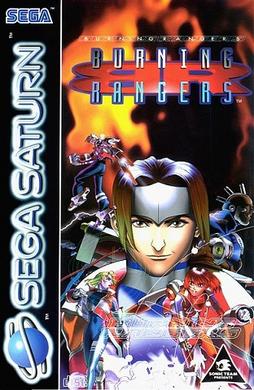
Burning Rangers is a 1998 action game developed by Sonic Team and published by Sega for the Sega Saturn. Burning Rangers is set in a futuristic society in which fire is the remaining danger. Players control one of an elite group of firefighters, the Burning Rangers, who extinguish fires and rescue civilians in burning buildings. Most of the tasks the players complete are centred around collecting energy crystals to transport civilians to safety. In lieu of an in-game map, Burning Rangers features a voice navigation system which directs players through corridors.

Magic Carpet is a 3D flying video game developed by Bullfrog Productions and published by Electronic Arts in 1994. Its graphics and gameplay were considered innovative and technically impressive at the time of its release.

Iron Man / X-O Manowar in Heavy Metal is a video game published by Acclaim Entertainment and developed by Realtime Associates for the PlayStation, Sega Saturn, Game Boy, Game Gear, and MS-DOS in 1996. It is a one or two-player side-scrolling action game in which the player battles villains from Marvel Comics' Iron Man and Valiant Comics' X-O Manowar comic book series. It was met with negative reviews which criticized it for dull gameplay and outdated graphics.

Viewpoint is an isometric-scrolling shooter arcade game developed by Aicom and originally released in 1992 by Sammy and SNK for the Neo Geo hardware family. It was met with a highly positive critical response upon release for its cutting-edge visuals and hip hop-influenced soundtrack, though later ports for the Sega Genesis and Sony PlayStation saw much more mixed reviews.
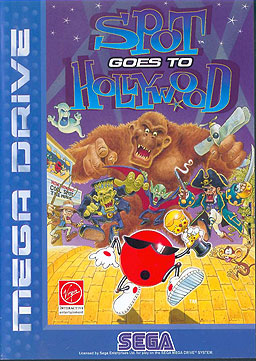
Spot Goes to Hollywood is a platform game developed by Eurocom and published by Acclaim Entertainment in North America and Virgin Interactive Entertainment in Europe for the Mega Drive/Genesis as the sequel to Cool Spot. Saturn and PlayStation versions were later released with full motion video clips and isometric graphics. The player controls Spot, once the mascot for the 7 Up soft drink, as it travels to various places trying to free its friends.

Gex is a platformer game developed by Crystal Dynamics. It was originally released for the 3DO in 1995; ports of the game for the PlayStation and Sega Saturn were later developed by Beam Software, and a Windows version was released by Microsoft. It was a pack-in game for Panasonic models of the 3DO later in the console's life. It is the first in the Gex series of video games, and introduces players to the title character, a wisecracking, television-obsessed gecko voiced by comedian Dana Gould, who must venture through the "Media Dimension" and defeat Rez, the overlord of the dimension who wants to make Gex into his new network mascot.
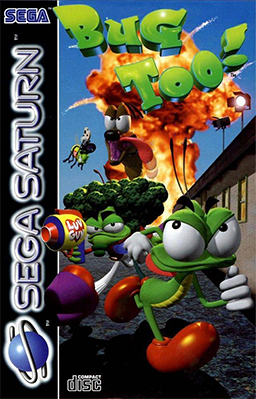
Bug Too! is a side-scrolling platforming video game developed by both Realtime Associates and SegaSoft. It is the sequel to Bug!, which was developed and published by Realtime Associates and Sega. It was first released for the Sega Saturn on December 6, 1996 in North America. It was later ported to Windows devices on December 10 of the same year in both North America and PAL regions. Finally, it was released in PAL regions for the Sega Saturn on April 24, 1997. Players are given the option of choosing from Bug, Maggot Dog, or Super Fly, a trio of action movie stars, who must proceed through a series of mostly 2D levels across multiple zones, with a boss level at the end of each zone.

Vectorman is a 2D action platformer video game developed by BlueSky Software and published by Sega. The game was released for the Sega Genesis in late 1995 in North America and Europe. It was considered a critical and commercial success, achieving its dual goal of retaining interest in the aging Sega Genesis platform in face of the increasingly popular new technology of the next generation of video game consoles and providing competition to industry competitor Nintendo's popular Donkey Kong Country video game. In subsequent decades, the game was re-released across many Sega-themed video game compilations, and on its own across the Wii Virtual Console, Steam, and the Sega Forever line of mobile game releases. A sequel, Vectorman 2, was released in 1996, but despite several abandoned attempts at making an Vectorman 3, no further games have been released.


















